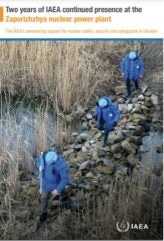
The International Atomic Energy Agency (IAEA) has issued a new report on its efforts to ensure nuclear safety and security during the conflict in Ukraine, two years after Director General Rafael Mariano Grossi first crossed the frontline to establish the IAEA’s Support & Assistance Mission to Zaporizhia (ISAMZ) at the site in September 2022.
The 36-page report highlights the challenges and achievements of the IAEA’s subsequent activities to protect ZNPP. During this time, the IAEA teams at the site have reported on incidents including shelling and drone strikes at the facility, which has also suffered repeated loss of off-site power events.
The situation at the ZNPP remains precarious and very fragile, Director General Grossi said in the report’s foreword. “Since 1 September 2022, IAEA staff have been deployed to the ZNPP, the largest nuclear power plant in Europe, which sits on the frontline of the armed conflict. On the occasion of this historic milestone, we take stock of the events that have shaped the past two years: the unprecedented difficulties, as well as the diligence of our staff in fulfilling their responsibilities with unwavering impartiality and professionalism.”
He notes: “This year alone, the teams have followed up on alleged drone strikes in the plant’s perimeter, damaged transformers, and a fire in one of the cooling towers. Fortunately, these incidents have not yet led to a radiological accident, however the risks to plant personnel, the international community and the public grows as the armed conflict continues.”
Assembling and maintaining the teams deployed to the ZNPP “has been a substantial undertaking, but we are aware of our critical mission and have been steadfast”. The objective and impartial assessments of the situation provided by our teams have made a significant contribution to maintaining nuclear safety, security and safeguards at the plant, he says.
The report notes that ZNPP has faced several challenges to its nuclear safety and security systems and structural integrity, “including the loss of the main cooling water source due to the destruction of the Kakhovka dam, large fire in one of the cooling towers and direct drone attacks”. The plant has experienced eight complete losses of off-site power, some of them lasting for days, and has sustained significant damage to its power grid connections.
“In each instance, IAEA teams independently analysed the situation and engaged in dialogue with the ZNPP to help find solutions to stabilize the situation and prevent a nuclear accident. The IAEA recommended the use of external diesel steam boilers, installed in 2024, to enable the plant to transfer all of its units to cold shutdown while ensuring a reliable source of steam for processing liquid radioactive waste. To date, there have been no releases of radioactive substances into the environment above regulatory limits and no damage to the integrity of nuclear fuel at the ZNPP.”
Walkdowns IAEA staff conducts walkdowns of the facility and hold technical discussions with the ZNPP To date there have 75+ walkdowns of the reactor buildings; 75+ walkdowns of the turbine buildings; 125+ walkdowns of the main control rooms; 350+ walkdowns of the switchyards, storage warehouses, cooling system facility, dry spent fuel storage, emergency diesel generators, pumping stations, rooftops of the reactor buildings, special buildings, training centre, and other areas; and 100+ discussions regarding the availability of safety systems, maintenance, spare parts and radiation monitoring systems.
According to the report: “The IAEA has faced restrictions in obtaining access to some areas. It continues to request timely and appropriate access to all areas of the ZNPP of significance or with potential implications for nuclear safety and security.”
Following Russia’s takeover of ZNPP, the automatic data transfer from the off-site radiation monitoring stations located within 30 kilometres of the plant was disrupted as Ukrainian officials could no longer supply the data to the Agency’s International Radiation Monitoring Information System (IRMIS). “In response, IAEA staff at the site ensured the off-line transmission to IRMIS of radiation monitoring data from the off-site stations. Independent radiation monitoring is regularly performed by IAEA staff at the site. To date, more than 100 radiation monitoring walkdowns have been conducted at the ZNPP.”
During the two years of continued presence, Grossi “has sustained continuous diplomatic efforts to maintain the nuclear safety and security of the ZNPP, including exchanges, meetings and consultations with high-level officials from Ukraine and the Russian Federation, and with their nuclear regulatory bodies.” He has addressed the UN Security Council on seven occasions to provide updates on the IAEA’s activities and has provided regular updates to the IAEA Board of Governors on the nuclear safety and security situation in Ukraine.
“Challenges continue to be faced at the ZNPP in ensuring that sufficient cooling water is available, maintaining a stable connection to off site power, maintaining adequate staffing arrangements, implementing a comprehensive preventative maintenance plan, and ensuring a reliable supply chain.”
The ongoing commitment and close cooperation of member states with the IAEA has been and continues to be essential to reduce the risk of a nuclear accident. “The IAEA remains committed to providing its unwavering support to help ensure the safe and secure operation of nuclear facilities and activities using radioactive sources in Ukraine.”






